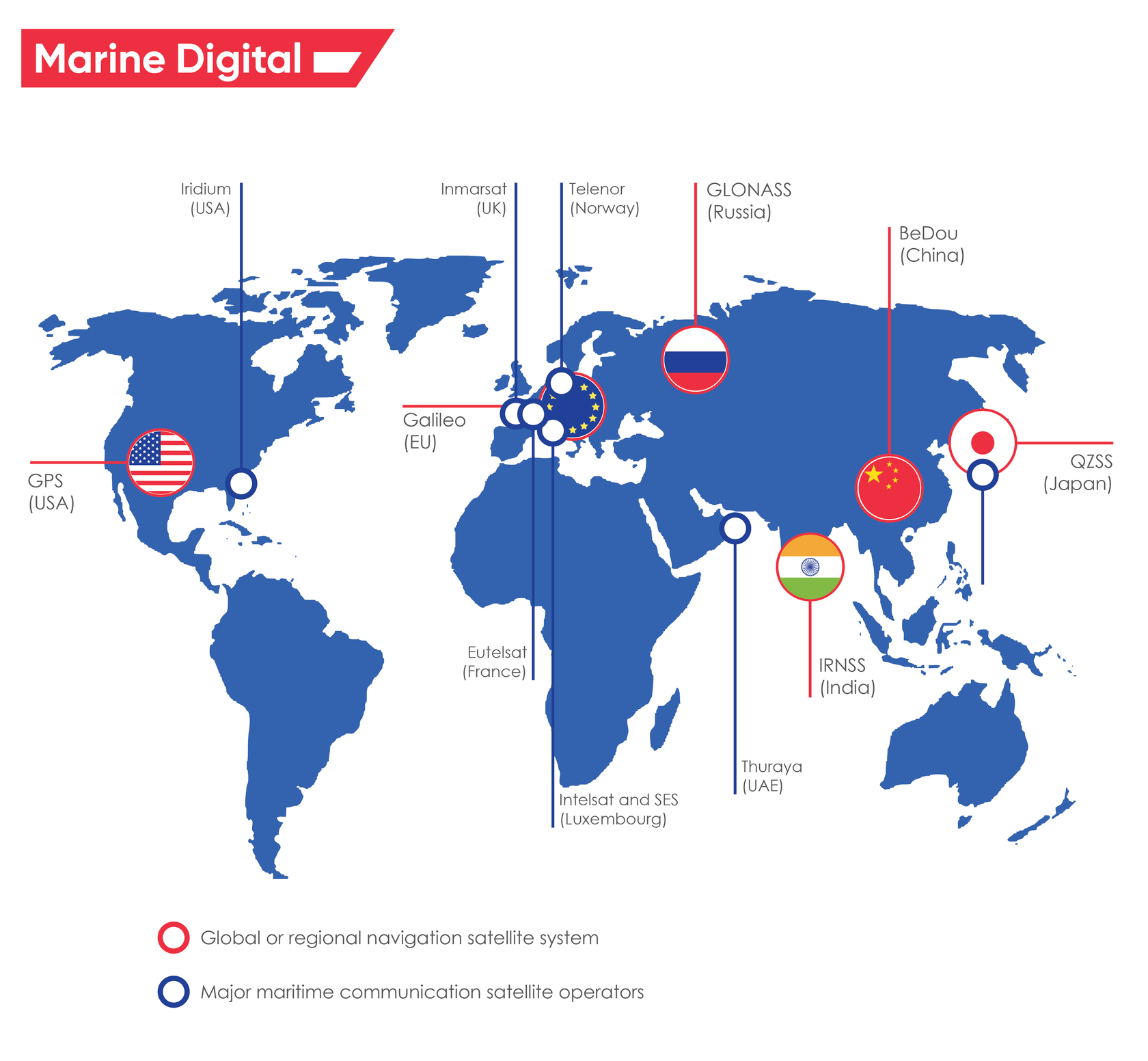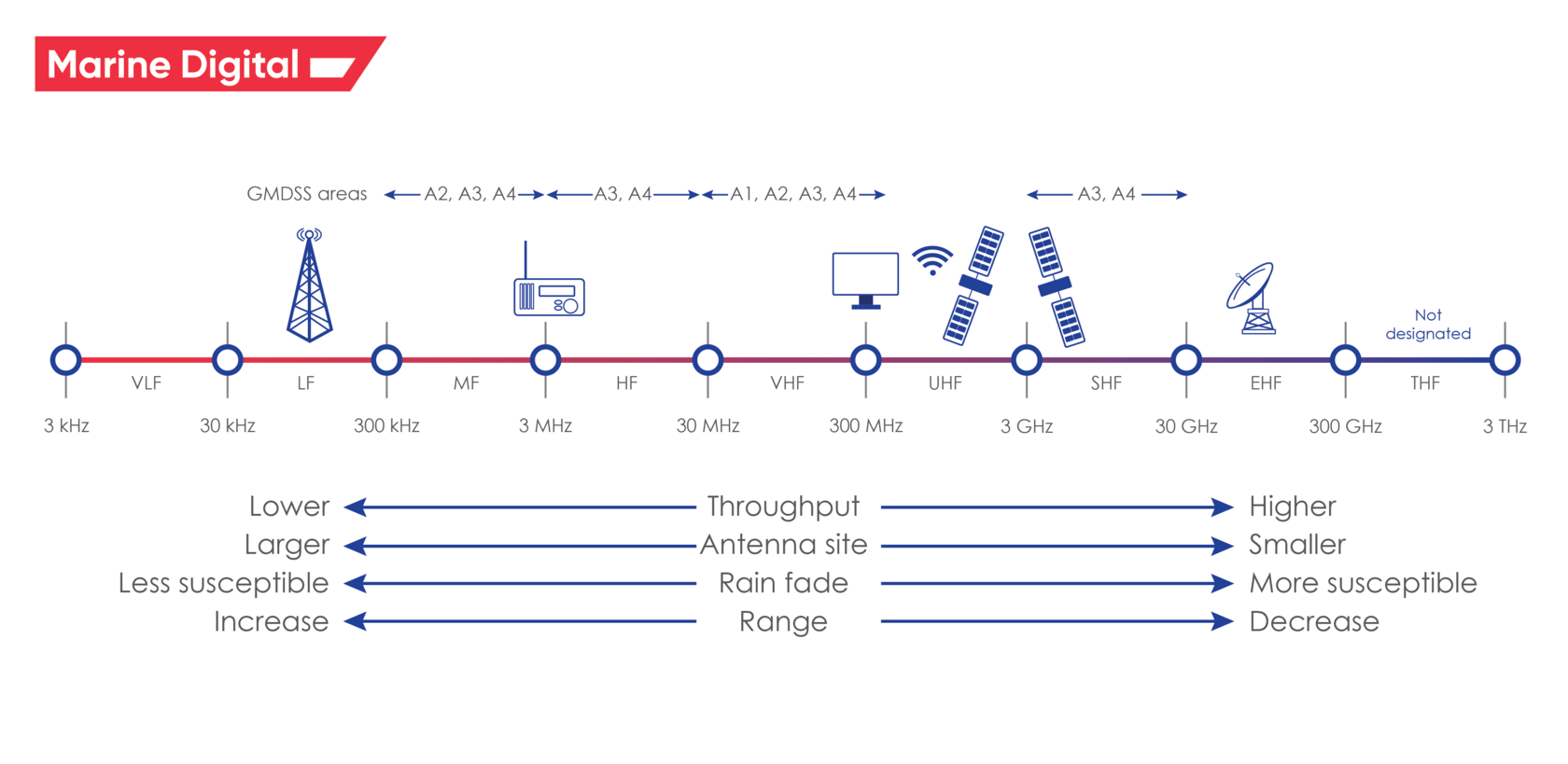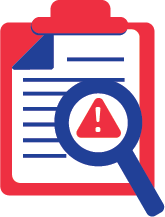Marine Communication
Today, ships generate, collect, and transmit an ever-increasing volume of data. To achieve efficient data transfer, wireless communications have been widely adopted for many years. Marine very high frequency (VHF) installations, satellites and WiFi
Today, ships generate, collect and transmit an ever-increasing volume of data. To achieve efficient data transfer, wireless communications have been widely adopted for many years. Marine very high frequency (VHF) installations, satellites and WiFi are just a few examples.
Radio media transmission adrift had gone through an ocean change in the only remaining century. After the times of semaphores and banners (which is as yet pertinent today at times), radio achieved an extreme change in marine correspondence adrift.
From the early long stretches of the only remaining century, ships began fitting radio for conveying trouble signals among themselves and with the shore. Radiotelegraphy utilizing Morse code was utilized in the early aspect of the 20th century for marine correspondence.
In the seventies, in the wake of thinking about the investigations of the International Telecommunication Union, IMO achieved a framework where transport to-transport or boat to-shore correspondence was placed without hesitation with some level of computerization, wherein a gifted radio official keeping 24×7 watch was not needed.
Marine correspondence between ships or with the shore was conveyed with the assistance of locally available frameworks through shore stations and even satellites. While transport-to-deliver correspondence was achieved by VHF radio, Digital Selective Calling (DSC) concocted carefully controller orders to send or get trouble ready, critical or wellbeing calls, or routine need messages. DSC regulators would now be able to be coordinated with the VHF radio according to the SOLAS (Safety Of Life at Sea) show.
Satellite administrations, instead of earthbound correspondence frameworks, need the assistance of geostationary satellites for sending and getting signals, where the scope of shore stations can't reach. These marine correspondence administrations are given by INMARSAT (a business organization) and COSPAS – SARSAT (a worldwide government-subsidized office).
While INMARSAT gives the extent of two-way correspondences, the COSPAS – SARSAT has a framework that is restricted to gathering of signs from the crisis position and places without any offices of two-way marine interchanges, showing radio signals (EPIRB).
For worldwide operational prerequisites, the Global Maritime Distress Safety System (GMDSS) has isolated the world into four sub-zones. These are four geological divisions named as A1, A2, A3, and A4.
Radio media transmission adrift had gone through an ocean change in the only remaining century. After the times of semaphores and banners (which is as yet pertinent today at times), radio achieved an extreme change in marine correspondence adrift.
From the early long stretches of the only remaining century, ships began fitting radio for conveying trouble signals among themselves and with the shore. Radiotelegraphy utilizing Morse code was utilized in the early aspect of the 20th century for marine correspondence.
In the seventies, in the wake of thinking about the investigations of the International Telecommunication Union, IMO achieved a framework where transport to-transport or boat to-shore correspondence was placed without hesitation with some level of computerization, wherein a gifted radio official keeping 24×7 watch was not needed.
Marine correspondence between ships or with the shore was conveyed with the assistance of locally available frameworks through shore stations and even satellites. While transport-to-deliver correspondence was achieved by VHF radio, Digital Selective Calling (DSC) concocted carefully controller orders to send or get trouble ready, critical or wellbeing calls, or routine need messages. DSC regulators would now be able to be coordinated with the VHF radio according to the SOLAS (Safety Of Life at Sea) show.
Satellite administrations, instead of earthbound correspondence frameworks, need the assistance of geostationary satellites for sending and getting signals, where the scope of shore stations can't reach. These marine correspondence administrations are given by INMARSAT (a business organization) and COSPAS – SARSAT (a worldwide government-subsidized office).
While INMARSAT gives the extent of two-way correspondences, the COSPAS – SARSAT has a framework that is restricted to gathering of signs from the crisis position and places without any offices of two-way marine interchanges, showing radio signals (EPIRB).
For worldwide operational prerequisites, the Global Maritime Distress Safety System (GMDSS) has isolated the world into four sub-zones. These are four geological divisions named as A1, A2, A3, and A4.

Diverse radio correspondence frameworks are required by the vessel to convey installed ships, contingent upon the zone of activity of that specific vessel.
A1 – It's around 20-30 nautical miles from the coast, which is under the inclusion of in any event one VHF coast radio broadcast in which consistent DSC alarming is accessible. Hardware utilized: A VHF, a DSC, and a NAVTEX collector (a navigational message for accepting sea and meteorological data).
A2 – This region notionally should cover 400 nautical miles seaward however practically speaking, it reaches out up to 100 nautical miles seaward yet this ought to avoid A1 territories. Gear utilized: A DSC, and radiotelephone (MF radio range) in addition to the hardware required for A1 regions.
A3 – This is the zone barring the A1 and A2 territories. Yet, the inclusion is inside 70 degrees north and 70 degrees south scope and is inside INMARSAT geostationary satellite range, where consistent alarming is accessible. Gear utilized: A high-recurrence radio and additionally INMARSAT, an arrangement of accepting MSI (Maritime Safety Information) in addition to the next outstanding frameworks for A1 and A2 zones.
A4 – These are the zones outside ocean territories of A1, A2, and A3. These are basically the Polar Regions North and South of 70 degrees of scope. Gear utilized: HF radio assistance in addition to those required for different territories.
A1 – It's around 20-30 nautical miles from the coast, which is under the inclusion of in any event one VHF coast radio broadcast in which consistent DSC alarming is accessible. Hardware utilized: A VHF, a DSC, and a NAVTEX collector (a navigational message for accepting sea and meteorological data).
A2 – This region notionally should cover 400 nautical miles seaward however practically speaking, it reaches out up to 100 nautical miles seaward yet this ought to avoid A1 territories. Gear utilized: A DSC, and radiotelephone (MF radio range) in addition to the hardware required for A1 regions.
A3 – This is the zone barring the A1 and A2 territories. Yet, the inclusion is inside 70 degrees north and 70 degrees south scope and is inside INMARSAT geostationary satellite range, where consistent alarming is accessible. Gear utilized: A high-recurrence radio and additionally INMARSAT, an arrangement of accepting MSI (Maritime Safety Information) in addition to the next outstanding frameworks for A1 and A2 zones.
A4 – These are the zones outside ocean territories of A1, A2, and A3. These are basically the Polar Regions North and South of 70 degrees of scope. Gear utilized: HF radio assistance in addition to those required for different territories.
All seas are secured by HF marine correspondence administrations for which the IMO requires two coast stations for each sea locale. Today practically all boats are fitted with satellite terminals for Ship Security Alerts System (SSAS) and for long-extend recognizable proof and following according to SOLAS necessities.
With the integration of 5G, WiFi and new generation satellites, as well as conventional marine radio communication networks, we will see transformation everywhere. Stakeholders will be able to monitor live audio and high definition (HD) or 3D video collected onboard. Radio-frequency identification (RFID) tags will support through-life asset management, including the tracking status of cargoes, as well as structural and machinery components. Crew will need to be trained to operate multiple communication tools. Evolution will take place in the workflow process. Physical onboard surveys will be replaced by remote monitoring. Regulatory compliance and enforcement will be achieved remotely without visiting the ship. Real-time decision-making in ship management and autonomous operation will become feasible. Emergency evacuation will be conducted more quickly and in a more transparent manner. Consumers will be able to track product supply chains from factories to retailers and scrutinise the shipping footprint along the journey. Meanwhile, we will see an improvement in the quality of interpersonal communication between ship and shore, as well as an improvement in the wellbeing of the crew.
With the integration of 5G, WiFi and new generation satellites, as well as conventional marine radio communication networks, we will see transformation everywhere. Stakeholders will be able to monitor live audio and high definition (HD) or 3D video collected onboard. Radio-frequency identification (RFID) tags will support through-life asset management, including the tracking status of cargoes, as well as structural and machinery components. Crew will need to be trained to operate multiple communication tools. Evolution will take place in the workflow process. Physical onboard surveys will be replaced by remote monitoring. Regulatory compliance and enforcement will be achieved remotely without visiting the ship. Real-time decision-making in ship management and autonomous operation will become feasible. Emergency evacuation will be conducted more quickly and in a more transparent manner. Consumers will be able to track product supply chains from factories to retailers and scrutinise the shipping footprint along the journey. Meanwhile, we will see an improvement in the quality of interpersonal communication between ship and shore, as well as an improvement in the wellbeing of the crew.


We in Marine Digital have created a hardware solution that provides ship-to-shore communication, accumulates and transmits data for vessel performance monitoring and fuel optimization system (FOS) in real time at a constant level of communication. Marine Digital FOS can also collect data from a ship and periodically transmit data for processing in the cloud and presenting statistical and analytical data in a single interface, both for officers on the ship and for managers of a shipping company on the shore.

TOP 5 factors contributing to lower fuel costs for Shipping companies
Get a presentation with a full description of the features and free pilot project with trial of Marine Digital FOS for 2 months
"Clicking the button, you consent to the processing of personal data and agree to the privacy policy"

Get an overview "The Pathway to Zero Carbon Shipping:
IMO Compliance and CII Optimization through SEEMP" on email and download it for FREE! Leave your email now!
"Clicking the button, you consent to the processing of personal data and agree to the privacy policy, as well as consent to subscribe to the newsletter. "
Аdvantage of Fuel Optimization System from Marine Digital:

Marine Digital FOS can be integrated with other system and third-party's solutions through the API. To implement vessel performance monitoring for any vessel, we are using mathematical algorithms, machine learning and the same equipment as in FOS. The more data we collect from vessels, the more precise reports and recommendations our system will perform according to your individual requirements in fleet management.
If you have any questions about the solutions and the Marine Digital System platform, write to us, we will be happy to answer
If you have any questions about the solutions and the Marine Digital System platform, write to us, we will be happy to answer

Increased business process speed

Reducing to zero the number of errors

Best offer to the clients

Reduction in operating expenses
Have a questions?





